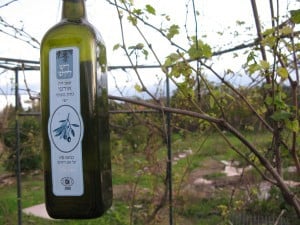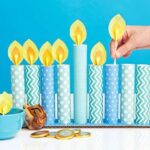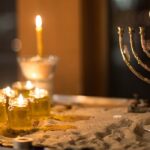What is Chanukah?
Chanukah celebrates the rededication of the Jerusalem Temple following its defilement by Syrian Greeks in 164 BCE. Since then, Chanukah has become known as the Festival of Lights, due to the one day supply of oil lasting a miraculous eight days, and is known for the traditional lighting of the hanukkiah. In addition, it is customary to feast upon fried foods and foods made with oil. Since Chanukah celebrates the idea of preserving resources, Hazon offers some Healthy, Sustainable Chanukah Resources as suggestions for your Chanukah celebrations!
Greening Chanukah
As you plan for your holiday festivities be sure to check out the Hazon Chanukah Greening Guide as well as 10 Ways to Make your Chanukah More Sustainable – both incredible resources from our Hazon programs team!
Make your own gifts or Chanukah crafts
This Chanukah we would like to to encourage you to get creative with your gifts and decorations. We have provided a list of fun, eco-friendly craft ideas for the whole family. When it comes to gifting, we like to gift from the heart rather than from the wallet. This year why not try making your gifts and decorations? Our staff members love to knit, paint and bake for our family and friends. Maybe cross-stitch your favorite fun Chanukah phrase onto a set of dish towels or try your hand at up-cycled tie-dye pillow cases. Please keep in mind, some of the most meaningful gifts are those that are not tangible- consider organizing a dinner with friends over zoom, writing a fun song to sing with your friends, or gifting acts of service like shoveling snow or taking on the dishes for the week.
Need More Inspiration? Check out the Hazon Holiday Gift Guide!
Looking for a New Year’s Resolution? Commit to a personal change!
Traditionally speaking, this is the time of year when we dedicate ourselves to self improvement and maintaining personal goals. This year we would like to encourage you to make a personal change that benefits not only yourself but the planet. After lighting your menorah each evening, dedicate yourself to being more environmentally sustainable and reducing your impact on the planet. A great, cost-free way to do this would be to look into joining the Brit Hazon. Brit Hazon is a 6-week personal commitment to change that is easy to sign up for at no cost to you. Better yet, tell your friends and join up together so that you can compare notes and share in the journey together.
Food & Recipes
Sustainability Tips
Buy Fair Trade chocolate. If you still want chocolate gelt, opt for Fair Trade choices. Our partners at T’ruah offer wonderful educational resources to explore guilt-free gelt. We recommend Equal Exchange, Divine Chocolate, or any bar with the Equal Exchange logo at your grocery store. Or try making your own gelt using sustainably sourced ingredients with this great Jew & the Carrot recipe!
Use local potatoes and onions. Potatoes and other root vegetables are in abundance during the winter. Stop by your local farmers market and stock up prior to making your Chanukah latkes.
Buy organic oil. Since Chanukah frequently involves oil in some form for every meal, buying organic oil or using RSPO sustainable palm oil ensures a more sustainable celebration.

Change up your latke. Toppings: Rather than buying a traditional brand of sour cream, stock up on an all-natural or organic sourcream. More of an applesauce fan? Make your own from apples purchased locally or buy an organic brand. Latke: You can use sweet potatoes instead of regular potatoes, or carrots as an added healthy bonus to give your latkes a different taste!
Eat less meat. Use the festive opportunity to cut down on meat consumption and eat some of the wonderful produce that is available during the winter months.
Use environmentally sustainable candles. Beeswax, soy, and palm oil provide more natural alternatives to the traditional paraffin Chanukah candles. Check out Big Dipper Wax Works or your local candle maker for environmentally sustainable Chanukah candles.
Reuse the Wrap. Reusable gift bags are a great way to be environmentally conscious as well as a great supplementary gift, a beautiful gift bag that the next individual can reuse! Check out Etsy for some awesome Chanukah themed reusable gift bags and wrap!
Green your Chanukah decorations. Try crafting a dreidel out of recyclable materials. Also, as a family or community activity, make your own hanukkiah using recycled materials you find around your house. Remember making an alphabet block hanukkiah as a child? Recreate the experience with your family or community, and see how creative you can make your hanukkiah! Here are some great suggestions from the Huffington Post about how to green your very own hanukkiah!
Make your Menorah more sustainable. Help reduce CO2 emissions and environmental damage through this covenant that attempts to heal the planet of the climate crisis of global scorching. Learn more about the Green Menorah Covenant Coalition. Or Ten Thousand Villages for recycled and sustainable menorah options.
Save paper. Send environmentally-friendly e-cards as opposed to the traditional paper cards. Or, buy cards made from recycled paper. In addition, recycled or recyclable paper when wrapping gifts. (Newspaper is always a cool idea that is especially fun for kids!)
Look for EnergyStar rebates. Find rebates and special offers near you on ENERGY STAR certified products. Products that earn the ENERGY STAR label meet strict energy-efficiency specifications set
by the U.S. EPA helping you save energy and money while protecting the environment. Click here for the rebate finder and here for the database of State Incentives for Renewables & Efficiency.
Cut down on waste! If you’re hosting a Chanukah party or large communal meal, use recyclable, reusable, or compostable plates and flatware. Additionally, try to use reusable table cloths and napkins. For tips on cutting back on waste, check out Chapter 3 of the Hazon Food Guide.
Eco-Friendly Crafts
Paper Tube Menorah
Cotton swabs form the flames for this playfully patterned menorah. For the base, cover a

3- by 12-inch piece of corrugated cardboard with scrapbook paper or let your kids paint their own design on them. Roll and tape 8 (4- by 5-inch) paper rectangles, and one that’s 4 by 7 inches, to form tubes. Dip one end of each tube in tacky glue and place the tubes on the base as shown. For each flame, cut a teardrop shape from orange card stock and a slightly larger teardrop from yellow tissue paper. Cover the orange piece with glue and then place a cotton swab on top. Smooth the tissue paper over the orange paper and swab, and let dry. To make your flames sit taller in their holders, pack crumpled tissue paper inside the tubes.
Chanukah Wreath

This is a great craft that uses common items and greenery found around the house and backyard. We love it’s minimalistic green design. We found this project here.
Here is the list of necessary materials:
- Greenery and Sticks
- Wire Cutters
- Florist Wire
- Twine
Here are the directions:
- Begin by taking one or two stems of your choice and lay them along a section of your star. Wrap a piece of florist wire (about 6cm long) tightly around the branch and stems and squeeze the ends together with the wire cutters. Do this a couple more times along the stem to secure the stems to the branch, laying the stems in different directions.
- You may need to tie some twine tightly around those points with heavier foliage to help secure the stems to the branch, as shown below.
- Continue along the frame of your star, adding stems and foliage here and there where desired. You can use previously wrapped wire points to stick more foliage into, and then secure with twine. Just layer the foliage as you go until you’re happy with how it looks.
Twig Menorah – we found this fun, family friendly craft here.
This unconventional flameless menorah for kids is a wonderful way to teach, share & pass on a beautiful tradition (and also happens to provide the perfect opportunity for a little counting and color-learning practice). Just like an actual menorah, you can add the “candles” together over the course of Hanukkah for a kid-safe celebration of lights!
Supplies:
- A piece of cardboard or cereal box
- Yellow/gold construction paper or cardstock
- Scissors or a utility knife
- A hole punch
- 8 or 9 sticks (about 3-4″ long)
- Paint and a brush
- A hot glue gun or craft glue
Optional Supplies:
- Moss, evergreen sprigs or other natural decoration
- Garden shears to cut twigs
- Collect 9 twigs of the same approximate length and width (you can usually break one larger stick into 2 or 3 smaller ones) You’ll also want 4 longer straight sticks to use along the edges of your menorah (a decorative touch, that also helps it keeps its shape and stand strong and sturdy). I thought it would be especially engaging for kids if it formed a rainbow of colors, so we painted each stick, but they’d look equally beautiful left untouched.
- Cut small, simple flame shapes out of a piece of cardstock or construction paper. Use a hot glue gun to affix a flame to the top of each twig candle. Note: It’s easier to push the stick into the cardboard base if the edge is fairly even, so if one side of your stick has a much more jagged edge, you may want to use that side for your paper flame.
- Use an X-acto knife or similar to cut an 18-inch x 2.5 inch (or larger) strip of cardboard from the side of a box. We painted our cardboard, but it’s an optional step. Once dry, fold in half and crease at the center.
- Make a mark in the middle of your cardboard strip, then use a ruler to mark off 4 more lines (equal distances apart) down each side of your cardboard strip. Using an X-Acto knife or boxcutter, cut small “X”s at each mark, then gently fold inwards (toward the bottom of your base). These create the holders for our twig candles. Remember to take into account the width of your twigs so your X’s don’t create a hole that’s too small/large. Note: If you *do* happen to make a hole that’s a bit too large, just wrap a bit of clay or playdough around your candle before adding it to the menorah!
- To stabilize your menorah and keep it standing tall, glue a small cardboard triangle-shaped support under the bend in the center.
- We thought we’d cover up a bit of the cardboard and embrace the natural theme by adding some dried mosses on top. We used the glue gun to make a big “S” shape, then started pressing dried grasses and mosses down on top!
- To add some support and give our edges a finishing touch, we used a hot glue gun to add stick edging to each side of our menorah. We were able to just break our sticks to the approximate length of each side, but you can use a pair of garden shears if your sticks are harder to break at the right spot.
- Gently pop the candles into your menorah each night from right to left, using the Shammash to “light” each one.
Hazon Resources
Food for Thought– A 130-page sourcebook that draws on a range of texts from within and beyond Jewish traditions to explore a range of topics relating to Jews and food.
Greening Chanukah Guide– The Hazon Greening Chanukah Guide is a great way to practically plan your celebration with environmental ethics in mind.
Decomposition & Chanukah – This post discusses the link between Chanukah and the lessons we can learn on longevity for the products we consume.
Share in Hazon family traditions!
While certain traditions are constant like lighting a menorah or spinning a dreidel, others that are more personal may be kept closer to the heart this time of year. We asked our staff to share their own family Chanukah traditions with our readers. Here were their answers:
“Every year for many years I could not eat regular potatoes or eggs so now we make our latkes with sweet potatoes and kosher “gelatin eggs”. It sounds crazy but it really works. We invite all of our friends and family over (most of whom are not Jewish; imagine 16 people in our tiny house….), light candles, and debate whether you can really tell the difference between vegan and regular sour cream on top of the latke.”
–Hannah Henza Director of National Programs
“I come from a musical family and every year on Chanuka my dad plays the piano and we sing songs. I haven’t lived at home in over a decade, but my parents still call me every Chanuka and we sing over the phone together!”
– Sara Pilavin, Special Events Coordinator
“We have a slightly “heavier” tradition every night after we light the candles we sit for at least half an hour and read the Book of Maccabis, the actual text Hannukah relies on. We discover fascinting facts, and every year there is something new. For instance, did you know that the Maccabis forged alliances with the Spartans and even with Rome? Did you know that the original name of Hannukah is “The Celebration of Sukkot and Fire”, because that year they did not celebrate Sukkot because it was in the middle of the war. When they won they celebrated for eight days, in lieu of Sukkot.”
– Aharon Ariel Lavi, Director of Hakhel
“Years ago, throughout my conversion process, I found that cooking and experiencing new foods was a wonderful way for me to get in touch with Judaism on a more personal level. On my first Chanukah I was given the traditional recommendations of applesauce or sour cream as a topping for my first latke and I was very excited to find out which “team” I would be placed into. My future-husband then told me his family did something strange and always topped their latkes with powdered sugar. Of course, I tried it and it’s now my go-to topping! This tradition makes me feel like I am not only part of the community but a special part of his family as well.”
-Rachel Miller, National Programs Marketing Coordinator
